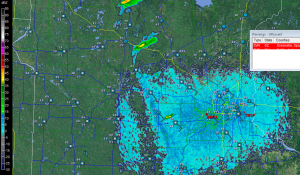Bob Hartig
EF5
One doesn't associate drylines with the Great Lakes states, but while rare, they do occur here from time to time. Here's an example of one in central Minnesota that I came across earlier while sifting through my archive of radar images. Check out the station obs along the fine line and you'll see what I'm talking about. The contrast in moisture may not be as drastic as you'd find out in the panhandles of Texas and Oklahoma, but it's nevertheless respectable, and the abrupt veering of surface winds across the boundary is noteworthy.
Some may say that "dryline" isn't the right word for this. I don't know of a better term to describe the phenomenon, but regardless of what you call it, it's an impressive source of lift, and with supercells firing along it and three tornado reports logged for that date (May 10, 2011) by the SPC, it obviously did the job.

Some may say that "dryline" isn't the right word for this. I don't know of a better term to describe the phenomenon, but regardless of what you call it, it's an impressive source of lift, and with supercells firing along it and three tornado reports logged for that date (May 10, 2011) by the SPC, it obviously did the job.



